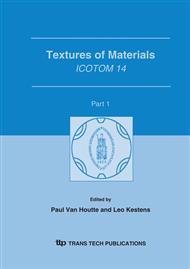p.1291
p.1297
p.1303
p.1309
p.1315
p.1323
p.1333
p.1343
p.1353
Cube Texture Development in Pure Ni during Annealing in a High Strength Magnetic Field
Abstract:
A 10 Tesla magnetic field was applied during annealing of cold-rolled high purity Ni at 300°C for 2 hours, with samples aligned at various different angles to the magnetic field direction. The effect of the magnetic field annealing on the cube texture evolution and the microstructural development was investigated by use of electron backscatter pattern (EBSP) analysis in the scanning electron microscope. The results show that both the cube texture evolution and the grain size are affected by the application during annealing of a high strength magnetic field, and that the effect varies as a function of the angle between the sample normal and the magnetic field direction. The cube texture volume fraction resulting from 2 hours annealing increases with increasing angle between the field direction and the sample normal direction, though in nearly all cases lower cube volume fractions were obtained compared to annealing without a magnetic field. The average size for all grains and for just cube-oriented grains both decrease with decreasing cube texture fraction, suggesting that the presence of a magnetic field either leads to enhanced recrystallization nucleation, or to a retardation of grain growth after recrystallization.
Info:
Periodical:
Pages:
1315-1322
Citation:
Online since:
September 2005
Authors:
Keywords:
Price:
Сopyright:
© 2005 Trans Tech Publications Ltd. All Rights Reserved
Share:
Citation:


